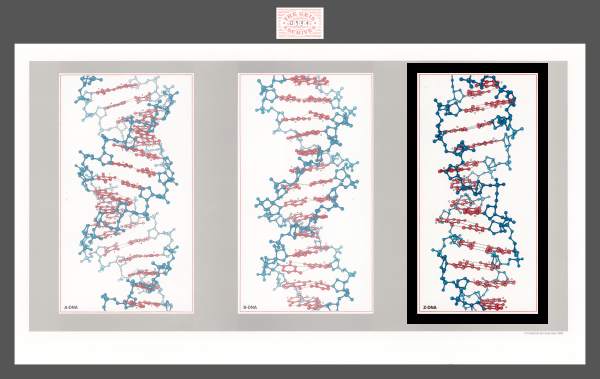Z-DNA
1983

Geis’ depicted version of the Z-helix shows the hallmark feature of this form of DNA, which is the left-handed nature of the molecule.
Used with permission from the Howard Hughes Medical Institute (www.hhmi.org). All rights reserved.


Related PDB Entry: 2DCG
Experimental Structure Citation
Wang, A. H., Quigley, G. J., Kolpak, F. J., Crawford, J. L., van Boom, J. H., van der Marel, G., & Rich, A. (1979). Molecular structure of a left-handed double helical DNA fragment at atomic resolution. Nature, 282, 680-686.
About Z-DNA
Molecule of the Month: Z-DNA
The DNA Z-helix occurs under high salt conditions (Goodsell, 2001). It also requires a particular base sequence, including numerous alternating cytosine-guanine and guanine-cytosine base pairs. Unlike the A- and B-helices, it is left-handed (which means that it winds in the opposite direction). It consists of 12 base pairs per turn (B-Form, A-Form, Z-Form of DNA).
Note: The depicted Chimera and Jmol structures (consisting of 12 base pairs) are predictions by Dr. Wilma Olsen based on the crystallized fragment (consisting of 4 base pairs) to match Geis’ illustration (Zheng et al., 2009).
Text References
B-Form, A-Form, Z-Form of DNA. University of California, Davis. URL: http://biowiki.ucdavis.edu/Core/Genetics/Unit_I%3A_Genes%2C_Nucleic_Acids%2C_Genomes_and_Chromosomes/2%3A_Structures_of_nucleic_acids/B-Form%2C_A-Form%2C_Z-Form_of_DNA
Goodsell, D. (2001). Molecule of the Month: DNA. DOI: 10.2210/rcsb_pdb/mom_2001_11
Zheng G., Lu X. J., & Olson W. K. (2009). Web 3DNA—a web server for the analysis, reconstruction, and visualization of three-dimensional nucleic-acid structures. Nuc. Acids Res. 37 (Web Server Issue), W240-W246






